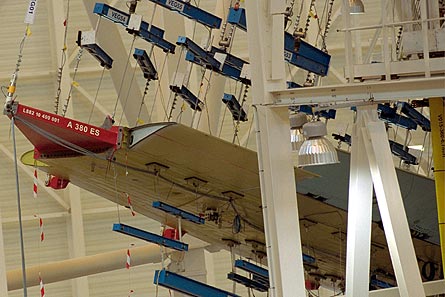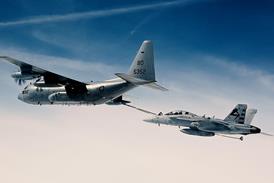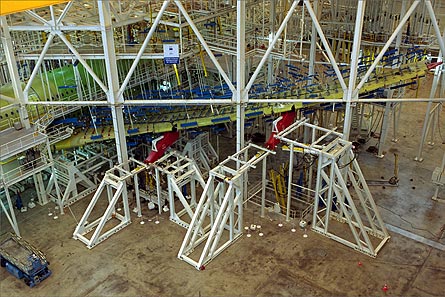The wing of the Airbus A380 static test specimen suffered a structural failure below the ultimate load target during trials in Toulouse earlier this week, but Airbus is confident that it will not need to modify production aircraft.
The airframer has been running load trials on a full scale A380 static test specimen in Toulouse since late 2004 (pictured below). After completing “limit load” tests (ie the maximum loads likely to experienced by the aircraft during normal service), progressively greater loads have been applied to the specimen towards the required 1.5 times the limit load. Engineers develop finite element models (FEM) to calculate the load requirements.
“The failure occurred last Tuesday between 1.45 and 1.5 times the limit load at a point between the inboard and outboard engines,” says Airbus executive vice president engineering Alain Garcia. “This is within 3% of the 1.5 target, which shows the accuracy of the FEM.” He adds that the ultimate load trial is an “extremely severe test during which a wing deflection of 7.4m (24.3ft) was recorded”.
The European Aviation Safety Agency (EASA) says that the maximum loading conditions are defined in the A380 certification basis. “The aircraft structure is analysed and tested to demonstrate that the structure can withstand the maximum loads, including a factor of safety of 1.5. This process is ongoing and will be completed before type certification.”
However Garcia says that the failure of the wing below the 1.5 target will require “essentially no modifications” to production aircraft: “This static test airframe has the first set of wings built, and we have refined the structural design for subsequent aircraft due to increased weights etc. We will use this calibration of the FEM to prove the adequacy of the structure on production aircraft.”
EASA says that it is aware of the structural failure but "cannot make a statement about the specific failure as it has not been officially briefed by Airbus on what the cause was, and the certification process is ongoing".
Garcia says that the FEM calculations had already established that the A380’s wing had “no margin at ultimate load. We had a weight saving programme and ‘played the game’ to achieve ultimate load.” However in earlier briefings, Airbus structural engineers had stated that it planned to carry out “a residual strength and margin research test” in 2006 after completing ultimate load trials.
The results gleaned from the static testing will be extrapolated for the future aircraft developments over the next 40 to 50 years says Garcia. “It is normal to refine and strengthen the structure of new heavier or longer range variants,” he says.
MAX KINGSLEY-JONES / LONDON
|
| Airbus has been running load trials on a full scale A380 static test specimen in Toulouse since late 2004 |
 |
Read Flight international's commercial aviation editor Max Kingsley-Jones explain how Airbus broke the story of how it broke the wing.
Source: Flight International
























